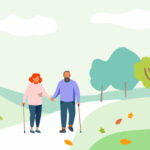The last few years have brought a new focus on mental health and helped to reinforce the importance of openly talking about it and mental illness. But is it just “feeling down,” or something more? With mental illness affecting millions of people in the US each year, it’s important for employees to understand when a change in mood may be more serious. October 7 is National Depression Screening Day, encouraging everyone to consider depression and mental health as routine parts of health care. Health screenings—whether through a workplace wellness plan, primary care physician (PCP), or clinic—can help identify serious illnesses, like depression, and connect people with treatment. Often depression symptoms may be brushed off or ignored, making screenings an essential tool.
Depression can include “a lack of interest and pleasure in daily activities, significant weight loss or gain, insomnia or excessive sleeping, lack of energy, inability to concentrate, feelings of worthlessness or excessive guilt and recurrent thoughts of death or suicide.” However, depression doesn’t look the same for everyone, and there are several forms of depression, often leading depression symptoms to be misunderstood.
This misunderstanding is costly to both employers and employees. Depression costs employers an estimated $44 billion in lost productivity each year. More than the money, half of all employees with depression do not seek treatment which makes this an ongoing issue without a simple solution. Depression can get better with the right treatment protocol but many affected adults dismiss their feelings as temporary sadness.
Sadness or Depression?
How can you tell the difference between depression and sadness? It’s a part of being human that we experience sadness or the feeling of being “low.” Being upset or sad when experiencing a breakup or losing a loved one is completely expected, and in a sense, even healthy. It’s true that depression is about being sad, but there’s more to it. You can experience something sad, but when it triggers one or more symptoms, including fatigue, loss of interest, difficulty sleeping or others, for at least two weeks or more at a time, this is considered an episode of depression. It may be time to seek help.
When that sadness impacts daily life, it could be depression.
It’s not uncommon for someone living with an anxiety disorder to also experience depression (or vice versa). About half of those diagnosed with depression are also diagnosed with an anxiety disorder. According to the U.S. Census Bureau nearly one third of adults reported anxiety and depression symptoms in 2023. Yet only 37 percent of those suffering receive treatment for these symptoms.
“Winter Blues” and Seasonal Affective Disorder
Seasonal changes can have a natural effect on our moods. Winter’s colder temperatures, shorter days and limited sunlight can make us want to withdraw and seek warm comforts. These feelings may last for a brief period without concern, but as with the other conditions discussed, it may be serious if it affects feeling, thinking, or daily activities. If seasonal change also brings on significant changes in your mood and behavior, that may be seasonal affective disorder (SAD), a type of depression.
As a form of depression, not a separate diagnosis, many of the symptoms are the same as depression, but occur seasonally, lasting about four to five months per year. Most people with SAD will experience it in the winter. Others may experience it in the summer though this is less common. As with any significant change in mood, don’t ignore it and just wait for it to go away. Talk to your doctor for a proper screening and get appropriate treatment.
Treatment Options
Depression is the most common mental disorder, and it is treatable. There are many options when it comes to seeking help for depression, anxiety or other mental health conditions. When any of these conditions start affecting your everyday routines and life, that is a sign to start your search for treatment.
The first step should be connecting with your primary care physician (PCP). Your doctor may ask you some questions about your symptoms and how you’ve been feeling and do a physical exam. They can offer many options but know it’s not a one-size-fits-all type of situation. The earlier you contact your doctor, the better. It takes trial and error to find the treatment that works best for you. Some options may include:
- Psychotherapy – Also known as “talk therapy” or cognitive behavioral therapy, psychotherapy is tailored to your specific condition. This teaches people different ways of thinking, behaving, and reacting to symptoms, thought patterns and situations. This may also be offered via a virtual visit through telehealth platforms.
- Medication – A provider may prescribe someone with anxiety and/or depression medication to help control symptoms, often in conjunction with other therapy. It’s important to fully understand any side effects from prescribed medications from your provider.
- Support groups – A group setting to share challenges and achievements with others can be useful for treating anxiety and depression.
- Stress management techniques – Activities such as exercise, mindful meditation and other methods can help calm and ease stress.
Mental Health Treatment and Benefits
The Affordable Care Act expanded coverage of mental health services; however, not every plan covers these services. Reach out to your HR benefits specialist or employee advocacy team to learn more about your employee benefits, what your insurance covers, in-network providers and any copays or coinsurance. Your employer may also offer an employee assistance program (EAP) that can provide short-term support while you find a provider and establish a treatment plan.
Even without insurance, there are many options for depression treatment.
If you don’t have insurance or your plan doesn’t cover mental health treatment, many providers offer low-cost or “sliding-scale” payments based on income. SAMHSA’s Behavioral Health Treatment Services Locator can help you find a local provider and National Alliance on Mental Illness’ HelpLine [1-800-950-NAMI (6264) or [email protected]] can answer questions and connect you with local resources. Most state Medicaid programs also cover many mental health treatments.
Don’t forget to reach out to family and friends for support as well. Turning to someone who you can trust and share with can help you take important next steps.
If you think you are experiencing depression and/or any other mental illness, make an appointment with your doctor to discuss a screening, possible treatments and other resources. The help you need is out there.
If you or someone you know is in immediate distress or is thinking about hurting themselves, you can call, text or chat through the 988 Lifeline website today.
American Psychological Association, “Depression”
Anxiety & Depression Association of America, “Facts & Statistics”
Center For Workplace Mental Health, “A Costly Condition for Businesses”
Heretohelp, “Questions and Answers”
KFF “ Latest Federal Data Show That Young People Are More Likely Than Older Adults to Be Experiencing Symptoms of Anxiety or Depression”
Mental Health America, “Am I Depressed or Just Sad?”
National Institute of Mental Health, “Anxiety Disorders”
National Institute of Mental Health, “Depression”
National Alliance on Mental Illness, “Mental Health By the Numbers”
National Institute of Mental Health, “Seasonal Affective Disorder”














